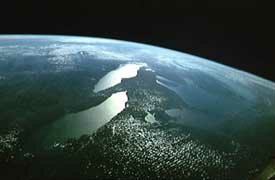Citizen Experiences with Shale Gas Drilling
New! Op-ed in the Erie-Times News
Letter sent to CHEC’s director, Conrad Dan Volz, DrPH, MPH:
Dear Dr Volz,
I am a resident of Susquehanna CO PA, ground zero for natural gas extraction using hydraulic fracturing. Oil and Gas were exempt during the Bush/Cheney administration from all environmental federal regulations for Clean Air, Water, the Chemical Disclosure Act, Superfund Act etc….via the HALLIBURTON Loophole. Halliburton developed fracking technology, and are one of the main drillers and also produce the chemicals used in the process. The industry does not have to reveal what toxic chemicals they are injecting into our ground through our aquifers… it is proprietary. I urge you to watch Josh Fox’s Sundance Winning documentary “GASLAND” if you have not already seen it.
We have no rights to clean drinking water; the industry is counting on getting eminent domain to extract the natural resources from under our ground and criss cross our land with pipelines they will not inspect: we are Class 1 areas and our lives per Federal and State regs are not worthy of a safety or even a routine pipeline inspection plan as we are in rural sparsely populated areas. These natural gas transmission and gathering lines will not serve PA residents, but will export natural gas out of our county and country and sold on the open market for the highest profit margin. We have been invaded by multinational natural gas corporations who are contaminating our drinking water, polluting our air, making us sick, and the state is on their side. No one….not even the lawyers ultimately… have stood up for Dimock residents’ right to a source of clean drinking water. The bottom line is profit, not our health, our water, our lives. Cabot Oil and Gas contaminated the Dimock aquifer and got away with it. Tomorrow is a panel discussion in La Port, PA featuring Anthony Ingraffea, PhD in Rock Fracture Technology, Cornell Univ., and Terry Engelder, PhD from Penn State, who holds a PhD from Texas A&M in Geosciences. Dr Engelder stated publicly that Dimock was a “necessary sactifice” for progress, Penn State has done a lot of research funded by the Oil and Gas industry. Dr Ingraffea, has spoken the truth about the dangers of shale gas extraction using “fracking” techniques… injecting millions of gallons of fresh water with thousands of pounds of chemicals like benzene, ethylbenzene, toluene under high pressure 8000 feet underground to fracture the marcellus shale and capture escaping gases. We need your expertise and voice on the insight you may offer about the longterm cumulative health and environmental impacts to help us get a handle on the war being waged on our communities.
What Oil and Gas is doing in PA, WY, CO, WV, they have done for decades in third world countries: driven the indigenous people off natural resources they wanted access to . Well, my county has been invaded by corporations who are treating us like indigenous natives: we are the new native americans to be cleared from the land; drill rig workers have told us we are in the way. Seismic testing companies have started working on land where no gas leases were signed and when confronted they said we are oil and gas and we will do what we want. We are a third world country to Cabot, Halliburton, Chesapeake etc. PA Homeland Security with the FBI’s consent hired an Israeli surveillance firm, ITRR (Institute for Terrorism Research and Response) to spy on anti-natural gas drillers, “those fomenting dissent”, and shared the information with the natural gas industry. The Marcellus Industry Coalition hired former PA Governor, former Head of Homeland Security, Tom Ridge, to do PR and lobby for them. They have portrayed the development of natural gas as a national security issue, and anyone who dissents is a terror threat. That means citizens trying to save their drinking water from contamination, citizens trying to educate their communities about the public health risks of drilling are terrorists. I attached a billboard we put up in our county that ended up analyzed in the Intelligence Bulletins. I am so sorry to ramble, but we need hope.
As a Pennsylvanian, if I litter on a state highway, e.g. throw a biodegradable banana peel on the road, I can be fined hundreds of dollars, yet the Halliburtons of the world…oil and gas….are polluting my air and water legally, and my state does not recognize my right to clean drinking water. We only have our own voices… we do not have millions of dollars to spend on lobbying so I am reaching out to you. Those of us living over marcellus shale, are the new native americans to be driven from their homes. We are the new third world population. The Susquehanna Watershed, the poor rural cousin to the wealthier more politically powerful Delaware Watershed, was allowed to be the guinea pig for marcellus shale extraction. But as the DRBC (Delaware River Basin Commission) has unveiled its owns set of rules and regulation for drilling, it seems they are readying to lift the moratorium in the Delaware Watershed before the EPA concludes its new comprehensive environmental impact study of marcellus shale extraction. The last one done in 2004 under Bush/Cheney…concluded shale gas extraction posed no threat at all to the environment. If you be willing to be on a panel discussion about marcellus shale, please let me know. Perhaps Iris Bloom of Protecting Our Water, based in Philly, could interview you on her new radio show FRACTURED DEMOCRACY…which is to be aired on a new truly grassroots public radio station WFTE in Scranton PA. I will send you her pilot program. Thanks, and I hope to hear from you.
Sincerely,
Rebecca Roter
Dual resident Bucks/Susquehanna CO’s PA
Videos by another local citizen:
“Dogs became ill after drinking water near a previous gas well site”
“Chemicals used on well site”
“During Steckman Ridge Compressor Station accidental emergency release in 2009″


